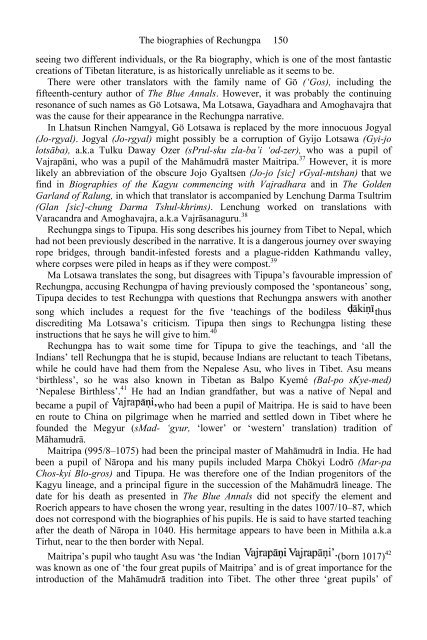The Biographies of Rechungpa: The Evolution of a Tibetan ...
The Biographies of Rechungpa: The Evolution of a Tibetan ...
The Biographies of Rechungpa: The Evolution of a Tibetan ...
You also want an ePaper? Increase the reach of your titles
YUMPU automatically turns print PDFs into web optimized ePapers that Google loves.
<strong>The</strong> biographies <strong>of</strong> <strong>Rechungpa</strong> 150<br />
seeing two different individuals, or the Ra biography, which is one <strong>of</strong> the most fantastic<br />
creations <strong>of</strong> <strong>Tibetan</strong> literature, is as historically unreliable as it seems to be.<br />
<strong>The</strong>re were other translators with the family name <strong>of</strong> Gö (‘Gos), including the<br />
fifteenth-century author <strong>of</strong> <strong>The</strong> Blue Annals. However, it was probably the continuing<br />
resonance <strong>of</strong> such names as Gö Lotsawa, Ma Lotsawa, Gayadhara and Amoghavajra that<br />
was the cause for their appearance in the <strong>Rechungpa</strong> narrative.<br />
In Lhatsun Rinchen Namgyal, Gö Lotsawa is replaced by the more innocuous Jogyal<br />
(Jo-rgyal). Jogyal (Jo-rgyal) might possibly be a corruption <strong>of</strong> Gyijo Lotsawa (Gyi-jo<br />
lotsāba), a.k.a Tulku Daway Ozer (sPrul-sku zla-ba’i ‘od-zer), who was a pupil <strong>of</strong><br />
Vajrapāni, who was a pupil <strong>of</strong> the Mahāmudrā master Maitripa. 37 However, it is more<br />
likely an abbreviation <strong>of</strong> the obscure Jojo Gyaltsen (Jo-jo [sic] rGyal-mtshan) that we<br />
find in <strong>Biographies</strong> <strong>of</strong> the Kagyu commencing with Vajradhara and in <strong>The</strong> Golden<br />
Garland <strong>of</strong> Ralung, in which that translator is accompanied by Lenchung Darma Tsultrim<br />
(Glan [sic]-chung Darma Tshul-khrims). Lenchung worked on translations with<br />
Varacandra and Amoghavajra, a.k.a Vajrāsanaguru. 38<br />
<strong>Rechungpa</strong> sings to Tipupa. His song describes his journey from Tibet to Nepal, which<br />
had not been previously described in the narrative. It is a dangerous journey over swaying<br />
rope bridges, through bandit-infested forests and a plague-ridden Kathmandu valley,<br />
where corpses were piled in heaps as if they were compost. 39<br />
Ma Lotsawa translates the song, but disagrees with Tipupa’s favourable impression <strong>of</strong><br />
<strong>Rechungpa</strong>, accusing <strong>Rechungpa</strong> <strong>of</strong> having previously composed the ‘spontaneous’ song,<br />
Tipupa decides to test <strong>Rechungpa</strong> with questions that <strong>Rechungpa</strong> answers with another<br />
song which includes a request for the five ‘teachings <strong>of</strong> the bodiless thus<br />
discrediting Ma Lotsawa’s criticism. Tipupa then sings to <strong>Rechungpa</strong> listing these<br />
instructions that he says he will give to him. 40<br />
<strong>Rechungpa</strong> has to wait some time for Tipupa to give the teachings, and ‘all the<br />
Indians’ tell <strong>Rechungpa</strong> that he is stupid, because Indians are reluctant to teach <strong>Tibetan</strong>s,<br />
while he could have had them from the Nepalese Asu, who lives in Tibet. Asu means<br />
‘birthless’, so he was also known in <strong>Tibetan</strong> as Balpo Kyemé (Bal-po sKye-med)<br />
‘Nepalese Birthless’. 41 He had an Indian grandfather, but was a native <strong>of</strong> Nepal and<br />
became a pupil <strong>of</strong> who had been a pupil <strong>of</strong> Maitripa. He is said to have been<br />
en route to China on pilgrimage when he married and settled down in Tibet where he<br />
founded the Megyur (sMad- ‘gyur, ‘lower’ or ‘western’ translation) tradition <strong>of</strong><br />
Māhamudrā.<br />
Maitripa (995/8–1075) had been the principal master <strong>of</strong> Mahāmudrā in India. He had<br />
been a pupil <strong>of</strong> Nāropa and his many pupils included Marpa Chökyi Lodrö (Mar-pa<br />
Chos-kyi Blo-gros) and Tipupa. He was therefore one <strong>of</strong> the Indian progenitors <strong>of</strong> the<br />
Kagyu lineage, and a principal figure in the succession <strong>of</strong> the Mahāmudrā lineage. <strong>The</strong><br />
date for his death as presented in <strong>The</strong> Blue Annals did not specify the element and<br />
Roerich appears to have chosen the wrong year, resulting in the dates 1007/10–87, which<br />
does not correspond with the biographies <strong>of</strong> his pupils. He is said to have started teaching<br />
after the death <strong>of</strong> Nāropa in 1040. His hermitage appears to have been in Mithila a.k.a<br />
Tirhut, near to the then border with Nepal.<br />
Maitripa’s pupil who taught Asu was ‘the Indian (born 1017) 42<br />
was known as one <strong>of</strong> ‘the four great pupils <strong>of</strong> Maitripa’ and is <strong>of</strong> great importance for the<br />
introduction <strong>of</strong> the Mahāmudrā tradition into Tibet. <strong>The</strong> other three ‘great pupils’ <strong>of</strong>











